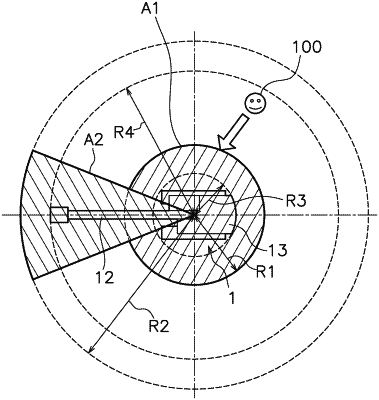| CPC E02F 9/2033 (2013.01) [E02F 9/24 (2013.01); E02F 9/22 (2013.01)] | 8 Claims |

|
1. A system for controlling a work machine that loads materials onto a conveyance vehicle,
the work machine including
a work implement, and
a rotating body to which the work implement is attached,
the system comprising:
a controller configured to control the work machine in an automatic control mode in which work is performed automatically; and
a detection device configured to detect a presence of a person in a peripheral region of the work machine,
the automatic control mode including
a loading mode in which the work implement and the rotating body of the work machine are caused to move to perform loading work for loading onto the conveyance vehicle, and
another mode other than the loading mode,
the controller being configured to cause the automatic control mode to transition from the other mode to the loading mode when a predetermined transition condition is satisfied,
the predetermined transition condition including non-detection of a person by the detection device,
when the presence of a person is detected by the detection device in a first region around the work machine during the loading mode, the controller is further configured to stop an operation of the rotating body but allow operation of the work implement,
when the presence of a person is detected by the detection device in a second region around the work implement during the loading mode, the controller is further configured to stop an operation of the work implement and the rotating body,
the first region being a predetermined first angular range disposed about a center of rotation of the rotating body,
the second region being a predetermined second angular range disposed about the center of rotation of the rotating body,
the second region extending in a direction in which the work implement is disposed with respect to the rotating body, and
the first angular range including a range excluding the second angular range within a range of 360 degrees about the center of rotation of the rotating body.
|
|
6. A method for controlling a work machine that loads materials onto a conveyance vehicle,
the work machine including
a work implement, and
a rotating body to which the work implement is attached,
the method comprising:
controlling the work machine in an automatic control mode for performing work automatically, the automatic control mode including
a loading mode in which the work machine is caused to move to perform loading work for loading onto the conveyance vehicle, and
another mode other than the loading mode; and
detecting a presence of a person in a peripheral region of the work machine; and
causing the automatic control mode to transition from the other mode to the loading mode when a predetermined transition condition is satisfied, the predetermined transition condition including non-detection of a person,
the controlling the work machine in the automatic control mode further including
when the presence of a person is detected by the detection device in a first region around the work machine during the loading mode, stopping operation of the rotating body but allowing operation of the work implement, and
when the presence of a person is detected by the detection device in a second region around the work implement during the loading mode, stopping operation of the work implement and the rotating body,
the first region being a predetermined first angular range disposed about a center of rotation of the rotating body,
the second region being a predetermined second angular range disposed about the center of rotation of the rotating body,
the second region extending in a direction in which the work implement is disposed with respect to the rotating body, and
the first angular range including a range excluding the second angular range within a range of 360 degrees about the center of rotation of the rotating body.
|